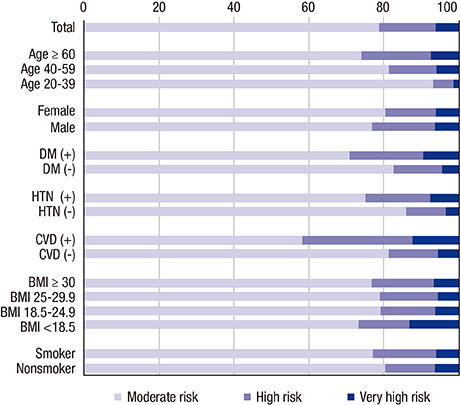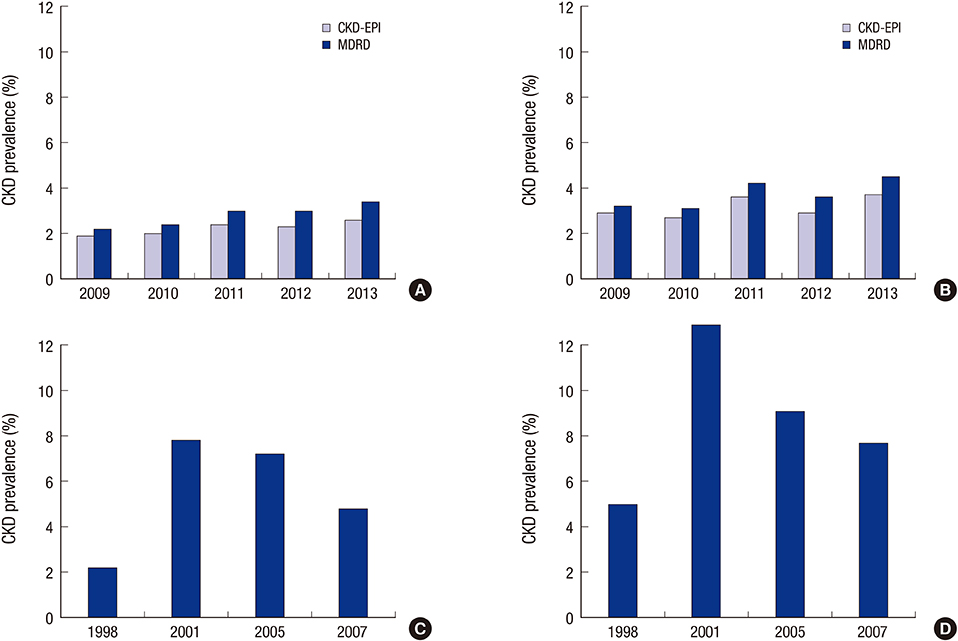Prevalence of Chronic Kidney Disease in Korea: the Korean National Health and Nutritional Examination Survey 2011-2013
- Affiliations
-
- 1Division of Nephrology, Department of Medicine, Kangwon National University Hospital, Kangwon National University School of Medicine, Chuncheon, Korea. haehyuk@kangwon.ac.kr
- KMID: 2373701
- DOI: http://doi.org/10.3346/jkms.2016.31.6.915
Abstract
- Chronic kidney disease is a leading public health problem related to poor quality of life and premature death. As a resource for evidence-informed health policy-making, we evaluated the prevalence of chronic kidney disease using the data of non-institutionalized adults aged ≥ 20 years (n = 15,319) from the Korean National Health and Nutrition Examination Survey in 2011-2013. Chronic kidney disease was defined as a urine albumin-to-creatinine ratio ≥ 30 mg/g or an estimated glomerular filtration rate < 60 mL/min/1.73 m2 using the Chronic Kidney Disease-Epidemiology Collaboration equation. The total prevalence estimate of chronic kidney disease for adults aged ≥ 20 years in Korea was 8.2%. By disease stage, the prevalence of chronic kidney disease was as follows: stage 1, 3.0%; stage 2, 2.7%; stage 3a, 1.9%; stage 3b, 0.4%; and stages 4-5, 0.2%. When grouped into three risk categories according to the 2012 Kidney Disease: Improving Global Outcomes guidelines, the proportions for the moderately increased risk, high risk, and very high risk categories were 6.5%, 1.2%, and 0.5%, respectively. Factors including older age, diabetes, hypertension, cardiovascular disease, body mass indexes of ≥ 25 kg/m2 and < 18.5 kg/m2, and rural residential area were independently associated with chronic kidney disease. Based on this comprehensive analysis, evidence-based screening strategies for chronic kidney disease in the Korean population should be developed to optimize prevention and early intervention of chronic kidney disease and its associated risk factors.
Keyword
MeSH Terms
Figure
Cited by 6 articles
-
Klotho and Postmenopausal Hormone Replacement Therapy in Women with Chronic Kidney Disease
Yoo Jin Park, Jun-Mo Kim
J Menopausal Med. 2018;24(2):75-80. doi: 10.6118/jmm.2018.24.2.75.Chronic Kidney Disease and Hepatitis B Virus Surface Antigenemia
Sung Woo Lee, Ho Jun Chin
J Korean Med Sci. 2018;33(42):. doi: 10.3346/jkms.2018.33.e274.The Association between Sitting Time, Physical Activity Level and Chronic Kidney Disease in the Healthy Adults
Doo Yong Park, On Lee, Yeon Soo Kim
Korean J Sports Med. 2017;35(1):32-39. doi: 10.5763/kjsm.2017.35.1.32.Real-World Prescription Patterns and Barriers Related to the Use of Sodium-Glucose Cotransporter 2 Inhibitors among Korean Patients with Type 2 Diabetes Mellitus and Cardiovascular Disease
Jong Ha Baek, Ye Seul Yang, Seung-Hyun Ko, Kyung Do Han, Jae Hyeon Kim, Min Kyong Moon, Jong Suk Park, Byung-Wan Lee, Tae Jung Oh, Suk Chon, Jong Han Choi, Kyu Yeon Hur
Diabetes Metab J. 2022;46(5):701-712. doi: 10.4093/dmj.2022.0002.Two-Year Changes in Diabetic Kidney Disease Phenotype and the Risk of Heart Failure: A Nationwide Population-Based Study in Korea
Seung Eun Lee, Juhwan Yoo, Han Seok Choi, Kyungdo Han, Kyoung-Ah Kim
Diabetes Metab J. 2023;47(4):523-534. doi: 10.4093/dmj.2022.0096.Real-world survival after colorectal surgery for malignancy in Korean patients with chronic kidney disease: an analysis of Korean healthcare big data, 2002–2019
Inho Song, Hyeryeong Nam, Bora Lee, Byung Kwan Park, Jeong-ki Kim, Seung-Bum Ryoo, Kyu Joo Park, Eon Chul Han
Ann Surg Treat Res. 2023;105(5):281-289. doi: 10.4174/astr.2023.105.5.281.
Reference
-
1. Matsushita K, Mahmoodi BK, Woodward M, Emberson JR, Jafar TH, Jee SH, Polkinghorne KR, Shankar A, Smith DH, Tonelli M, et al. Comparison of risk prediction using the CKD-EPI equation and the MDRD study equation for estimated glomerular filtration rate. JAMA. 2012; 307:1941–1951.2. Go AS, Chertow GM, Fan D, McCulloch CE, Hsu CY. Chronic kidney disease and the risks of death, cardiovascular events, and hospitalization. N Engl J Med. 2004; 351:1296–1305.3. Chow FY, Briganti EM, Kerr PG, Chadban SJ, Zimmet PZ, Atkins RC. Health-related quality of life in Australian adults with renal insufficiency: a population-based study. Am J Kidney Dis. 2003; 41:596–604.4. Awuah KT, Finkelstein SH, Finkelstein FO. Quality of life of chronic kidney disease patients in developing countries. Kidney Int Suppl. 2011; 2013:227–229.5. World Health Organization. Global burden of disease (GBD). accessed on 19 November 2015. Available at http://www.who.int/healthinfo/global_burden_disease/gbd/en/.6. Murray CJ, Lopez AD. Measuring the global burden of disease. N Engl J Med. 2013; 369:448–457.7. Coresh J, Selvin E, Stevens LA, Manzi J, Kusek JW, Eggers P, Van Lente F, Levey AS. Prevalence of chronic kidney disease in the United States. JAMA. 2007; 298:2038–2047.8. Zhang L, Wang F, Wang L, Wang W, Liu B, Liu J, Chen M, He Q, Liao Y, Yu X, et al. Prevalence of chronic kidney disease in China: a cross-sectional survey. Lancet. 2012; 379:815–822.9. Kim S, Lim CS, Han DC, Kim GS, Chin HJ, Kim SJ, Cho WY, Kim YH, Kim YS. The prevalence of chronic kidney disease (CKD) and the associated factors to CKD in urban Korea: a population-based cross-sectional epidemiologic study. J Korean Med Sci. 2009; 24:Suppl. S11–21.10. Levin A, Stevens PE. Summary of KDIGO 2012 CKD Guideline: behind the scenes, need for guidance, and a framework for moving forward. Kidney Int. 2014; 85:49–61.11. Levey AS, Stevens LA, Schmid CH, Zhang YL, Castro AF 3rd, Feldman HI, Kusek JW, Eggers P, Van Lente F, Greene T, et al. A new equation to estimate glomerular filtration rate. Ann Intern Med. 2009; 150:604–612.12. Hallan SI, Coresh J, Astor BC, Asberg A, Powe NR, Romundstad S, Hallan HA, Lydersen S, Holmen J. International comparison of the relationship of chronic kidney disease prevalence and ESRD risk. J Am Soc Nephrol. 2006; 17:2275–2284.13. Gambaro G, Yabarek T, Graziani MS, Gemelli A, Abaterusso C, Frigo AC, Marchionna N, Citron L, Bonfante L, Grigoletto F, et al. Prevalence of CKD in northeastern Italy: results of the INCIPE study and comparison with NHANES. Clin J Am Soc Nephrol. 2010; 5:1946–1953.14. Arora P, Vasa P, Brenner D, Iglar K, McFarlane P, Morrison H, Badawi A. Prevalence estimates of chronic kidney disease in Canada: results of a nationally representative survey. CMAJ. 2013; 185:E417–23.15. Imai E, Horio M, Watanabe T, Iseki K, Yamagata K, Hara S, Ura N, Kiyohara Y, Moriyama T, Ando Y, et al. Prevalence of chronic kidney disease in the Japanese general population. Clin Exp Nephrol. 2009; 13:621–630.16. Teo BW, Xu H, Wang D, Li J, Sinha AK, Shuter B, Sethi S, Lee EJ. GFR estimating equations in a multiethnic Asian population. Am J Kidney Dis. 2011; 58:56–63.17. Jeong TD, Lee W, Chun S, Lee SK, Ryu JS, Min WK, Park JS. Comparison of the MDRD study and CKD-EPI equations for the estimation of the glomerular filtration rate in the Korean general population: the fifth Korea National Health and Nutrition Examination Survey (KNHANES V-1), 2010. Kidney Blood Press Res. 2013; 37:443–450.18. Coresh J, Astor BC, McQuillan G, Kusek J, Greene T, Van Lente F, Levey AS. Calibration and random variation of the serum creatinine assay as critical elements of using equations to estimate glomerular filtration rate. Am J Kidney Dis. 2002; 39:920–929.19. Myers GL, Miller WG, Coresh J, Fleming J, Greenberg N, Greene T, Hostetter T, Levey AS, Panteghini M, Welch M, et al. Recommendations for improving serum creatinine measurement: a report from the Laboratory Working Group of the National Kidney Disease Education Program. Clin Chem. 2006; 52:5–18.20. Kang HT, Lee J, Linton JA, Park BJ, Lee YJ. Trends in the prevalence of chronic kidney disease in Korean adults: the Korean National Health and Nutrition Examination Survey from 1998 to 2009. Nephrol Dial Transplant. 2013; 28:927–936.21. Lee SW, Kim YC, Oh SW, Koo HS, Na KY, Chae DW, Kim S, Chin HJ. Trends in the prevalence of chronic kidney disease, other chronic diseases and health-related behaviors in an adult Korean population: data from the Korean National Health and Nutrition Examination Survey (KNHANES). Nephrol Dial Transplant. 2011; 26:3975–3980.22. Yu M, Ryu DR, Kim SJ, Choi KB, Kang DH. Clinical implication of metabolic syndrome on chronic kidney disease depends on gender and menopausal status: results from the Korean National Health and Nutrition Examination Survey. Nephrol Dial Transplant. 2010; 25:469–477.23. Levey AS, Coresh J, Greene T, Marsh J, Stevens LA, Kusek JW, van Lente F; Chronic Kidney Disease Epidemiology Collaboration. Expressing the Modification of Diet in Renal Disease Study equation for estimating glomerular filtration rate with standardized serum creatinine values. Clin Chem. 2007; 53:766–772.24. Nitsch D, Grams M, Sang Y, Black C, Cirillo M, Djurdjev O, Iseki K, Jassal SK, Kimm H, Kronenberg F, et al. Associations of estimated glomerular filtration rate and albuminuria with mortality and renal failure by sex: a meta-analysis. BMJ. 2013; 346:f324.25. Gutiérrez OM, Khodneva YA, Muntner P, Rizk DV, McClellan WM, Cushman M, Warnock DG, Safford MM. REGARDS Investigators. Association between urinary albumin excretion and coronary heart disease in black vs white adults. JAMA. 2013; 310:706–714.26. Gansevoort RT, Matsushita K, van der Velde M, Astor BC, Woodward M, Levey AS, de Jong PE, Coresh J; Chronic Kidney Disease Prognosis Consortium. Lower estimated GFR and higher albuminuria are associated with adverse kidney outcomes. A collaborative meta-analysis of general and high-risk population cohorts. Kidney Int. 2011; 80:93–104.27. Foster MC, Hwang SJ, Larson MG, Parikh NI, Meigs JB, Vasan RS, Wang TJ, Levy D, Fox CS. Cross-classification of microalbuminuria and reduced glomerular filtration rate: associations between cardiovascular disease risk factors and clinical outcomes. Arch Intern Med. 2007; 167:1386–1392.28. van der Velde M, Matsushita K, Coresh J, Astor BC, Woodward M, Levey A, de Jong P, Gansevoort RT, van der Velde M, Matsushita K, et al. Lower estimated glomerular filtration rate and higher albuminuria are associated with all-cause and cardiovascular mortality. A collaborative meta-analysis of high-risk population cohorts. Kidney Int. 2011; 79:1341–1352.29. Fox CS, Larson MG, Leip EP, Culleton B, Wilson PW, Levy D. Predictors of new-onset kidney disease in a community-based population. JAMA. 2004; 291:844–850.30. Domrongkitchaiporn S, Sritara P, Kitiyakara C, Stitchantrakul W, Krittaphol V, Lolekha P, Cheepudomwit S, Yipintsoi T. Risk factors for development of decreased kidney function in a southeast Asian population: a 12-year cohort study. J Am Soc Nephrol. 2005; 16:791–799.31. Centers for Disease Control and Prevention (CDC). National diabetes statistics report, 2014. accessed on 19 November 2015. Available at http://www.cdc.gov/diabetes/pubs/statsreport14/national-diabetes-report-web.pdf.
- Full Text Links
- Actions
-
Cited
- CITED
-
- Close
- Share
- Similar articles
-
- Association between chronic kidney disease and tooth loss in elderly Koreans: The Korea National Health and Nutrition Examination Survey 2016-2018
- Plan and Operation of the 4th Korea National Health and Nutrition Examination Survey (KNHANES IV)
- Relationship between Chronic Kidney Disease and Depression in Elderly Koreans Using the 2013 Korea National Health and Nutrition Examination Survey Data
- Association between Hypothyroidism and Chronic Kidney Disease in Korean Adults: A Study Based on the Sixth Korea National Health and Nutrition Examination Survey (KNHANES VI), 2013–2015
- Obesity, hypertension, diabetes mellitus, and hypercholesterolemia in Korean adults before and during the COVID-19 pandemic: a special report of the 2020 Korea National Health and Nutrition Examination Survey



